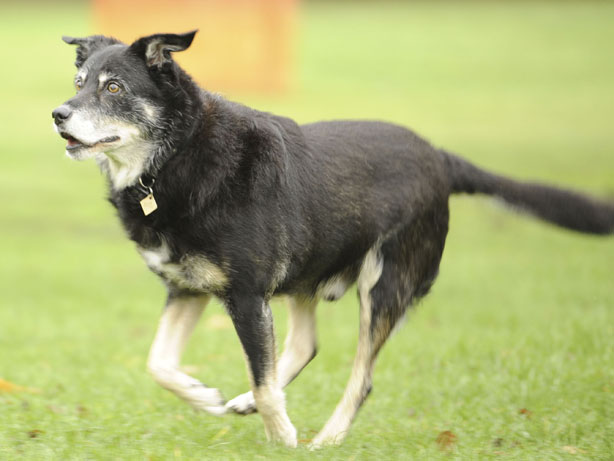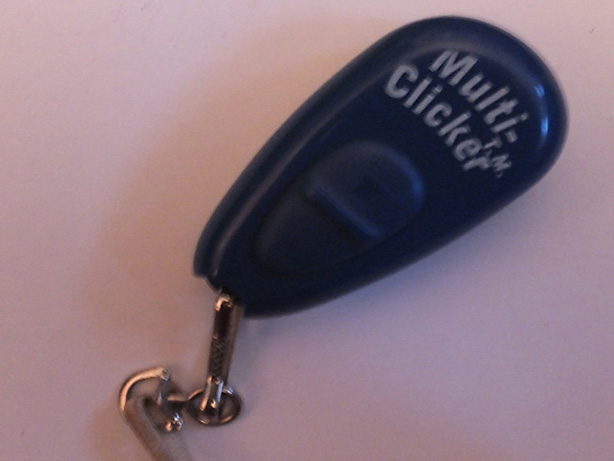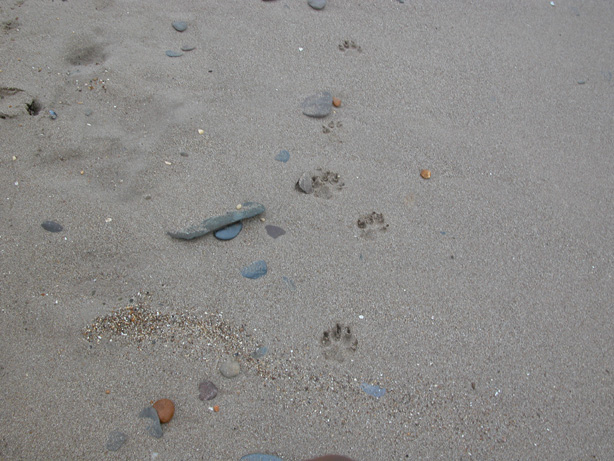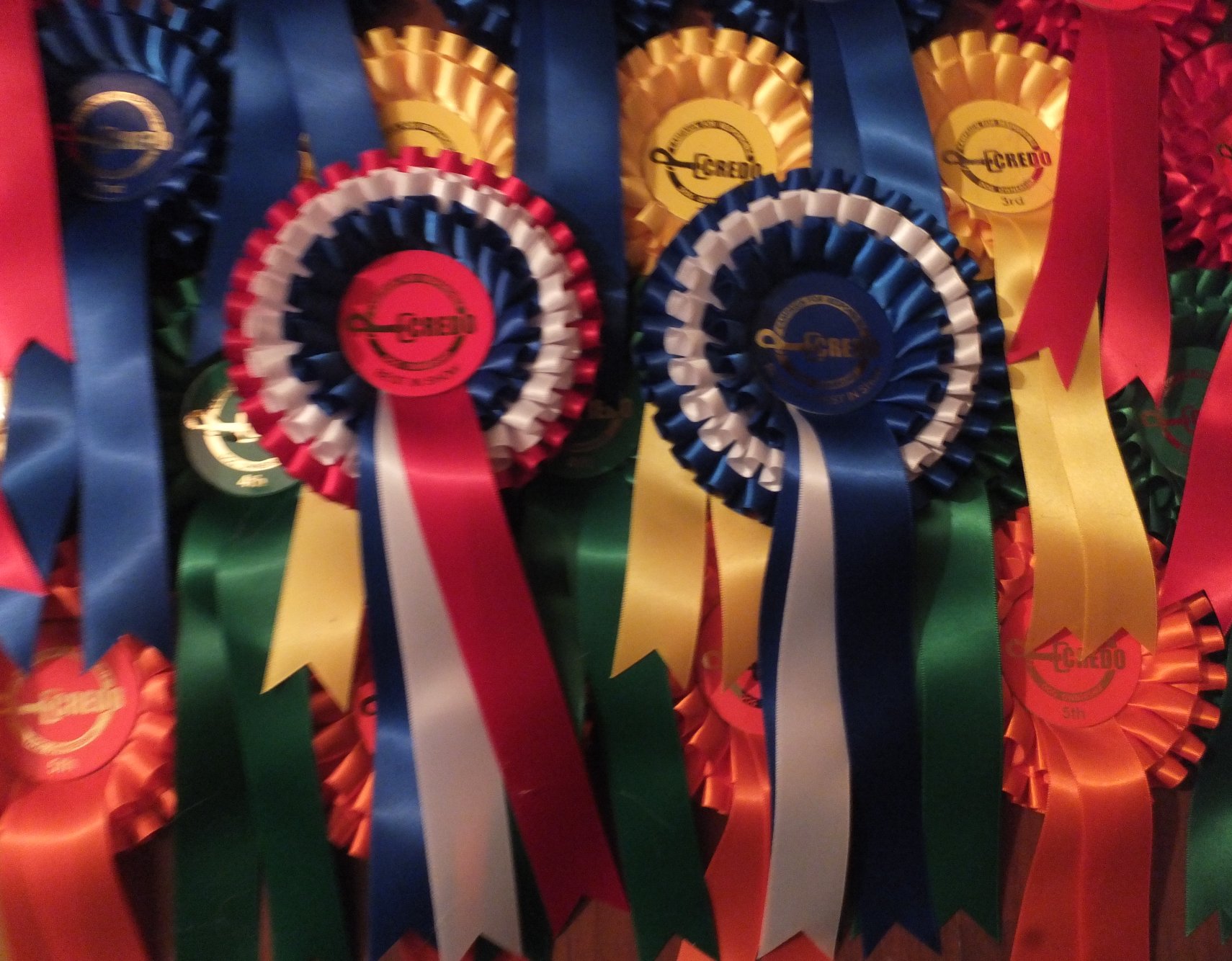
Canine Road Fatalities in Wales

UPDATE: The deliberate execution of the foxhound was referred to the Independent Police Complaints Commission (IPCC) “because of the level of public concern” over the decision. The IPCC determined that North Wales Police should continue with its own investigation and advised on the makeup of the review panel which it recommended should include a vet, a representative of the RSPCA and a senior officer from the Metropolitan Police Dog Support Unit. Sadly, but perhaps unsurprisingly, the review exonerated the officer who sanctioned the action as well as those involved. It has also recommended that patrol vehicles should carry slip leads and nets and that officers should obtain expert advice from dog handlers and vets in a similar situation. Deputy Chief Constable Gareth Pritchard said: “It is regrettable that the dog died in this way and I fully understand the level of public concern.”
CReDO and DogsNet would also like to express regret: the decision to end a dog’s life in this way was in no way acceptable. It was not guaranteed to end in a quick and painless death for the dog and could have resulted in the police involved in the execution being injured physically as well as emotionally. Even if the dog could not have been caught, it could have been herded well away from the road where it was more likely to be captured safely, if not by the police, by hunt staff.
A loose dog was run over on the A4232 southbound in south Wales during this morning’s rush hour, resulting in minor injuries to one driver and lengthy traffic jams. A second loose dog was caught by police. No details have as yet been released as to the circumstances that led to the dogs being on the road.
Meanwhile, the police continue to ignore owners who walk their dogs off lead on roads and many appear to not even know that this violates the Road Traffic Act 1988, Section 27. This law does of course not apply to working dogs.
Today’s incident follows the horrific and deliberate execution of a foxhound by north Wales police on the A55 in Conwy, north Wales at the beginning of the week.
The foxhound was running toward oncoming traffic between the Llanfairfechan roundabout and the Conwy tunnel in the early hours of Monday. Chief Inspector Wareing later stated that “The only safe option was to run the dog over at sufficient speed to ensure that it was destroyed and would not suffer. Other methods of destruction were considered, but were ruled out on the grounds of public safety”.
It seems more likely that the police were not prepared to halt traffic whilst the dog was removed from the carriageway. This appalling action has been referred to the Police and Crime Commissioner for North Wales and the Independent Police Complaints Commission.
Hunt staff and followers do of course take every precaution to keep their hounds away from roads.
Too Chicken To Feed Raw
 The Food Standards Agency (FSA) has just published news of the reduction in Campylobacter contamination in raw chicken tested between October and December 2015. 966 samples of fresh, whole chilled UK-produced chickens and packaging purchased from large retail outlets, smaller independent stores and butchers were tested.
The Food Standards Agency (FSA) has just published news of the reduction in Campylobacter contamination in raw chicken tested between October and December 2015. 966 samples of fresh, whole chilled UK-produced chickens and packaging purchased from large retail outlets, smaller independent stores and butchers were tested.
11% of chickens tested positive for the highest level of contamination as opposed to 19% in the same period in 2014. Campylobacter was present in 59% of chicken samples, a reduction of 15% from 2014.
Whilst this is a step in the right direction, it still represents a high level of contamination. Campylobacter jejuni and Campylobacter coli live in the gastrointestinal tract of mammals including dogs. Contact with an infected person or animal can cause the bacteria to spread. The incubation period is usually between 2 and 5 days, but it can be as short as 1 day and up to 11 days.
Early symptoms in humans can include fever, headache and muscle pain which can be severe and last up to 24 hours. Bloody diarrhoea, cramps, abdominal pain and high fever typically follow and last for 2–10 days.
Many infected dogs are asymptomatic: 23 – 41% of healthy pet dogs have been identified as positive in tests (and will be shedding bacteria into the environment). Up to 88% of kennelled dogs were infected. Stress, the presence of other diseases or pregnancy may increase susceptibility to develop the disease. Dogs typically suffer watery, bile-stained, bloody diarrhoea including mucus for between 5 and 15 days. Occasionally diarrhoea can last for months and inflammation of the gall-bladder (cholecystitis) and bacterial infection of the bloodstream (bacteraemia) can result. Infected individuals may remain as carriers even after treatment with antibiotics and continue to present a risk to any other animals (including humans) with which they come into contact.
Make you want to barf or feed BARF?
Adding Insult to Injury
 I was listening to an item on radio 4 last night about the aftermath of the devastating floods in York. The reporter was visiting roads that had been flooded and speaking to the remaining residents.
I was listening to an item on radio 4 last night about the aftermath of the devastating floods in York. The reporter was visiting roads that had been flooded and speaking to the remaining residents.
It must always be difficult finding alternative accommodation at short notice in such circumstances; many people had found rented premises. However, one man was remaining in unsuitable conditions after his house had been flooded up the skirting boards because he could not find a landlord that would accept his dogs.
This is a disgraceful situation. No doubt there would be an outcry if landlords en masse refused to accept children because they are noisy, may draw on the walls or play ball games and annoy the neighbours. More than a quarter of the popoulation of the UK own dogs: now we might not be the most houseproud of people but our dogs are by and large perfectly capable of living civilised lives alongside humans when trained well.
We must continue to campaign for fair access for dog owners to all appropriate areas of society, including housing. Owners must take responsiblity for their dog’s behaviour and take the consequences if their dog does cause damage. However, the default position should not be one of prejudice against dogs because of the behaviour of a minority.
Details of dog friendly housing and dog friendly letting, along with other campaigns, can be accessed via the DogsNet Campaigns for Access page.
Coming Up For Air
 Following on from the furore in Sweden and worldwide when Swedish judge Åke Cronander awarded a pug an Excellent rating at a show in Sweden in spite of the fact that it was evidently in respiratory distress (see Swedish Vets and SKK Lead The Way), Swedish vets have continued to take a lead in preventing further suffering in brachycephalic dogs.
Following on from the furore in Sweden and worldwide when Swedish judge Åke Cronander awarded a pug an Excellent rating at a show in Sweden in spite of the fact that it was evidently in respiratory distress (see Swedish Vets and SKK Lead The Way), Swedish vets have continued to take a lead in preventing further suffering in brachycephalic dogs.
Two Swedish veterinary ophthalmologists have make a public statement asking for a ban on breeding severely brachycephalic breeds (see Pedigree Dogs Exposed Blog for full details). This will no doubt provoke a storm of protest from owners and breeders who seem blind to the suffering of these dogs but it is an urgent consideration that has to be made because of the appalling breeding practices that have led to this situation. Of course, brachycephalic dogs are not the only breeds that are severely affected by heritable diseases – Cavalier King Charles spaniels with MVD and syringomyelia spring to mind for instance.
Should we seriously consider that some of the breeds with which we have become familiar over the last hundred years or so should be allowed to become extinct? Is it possible to outcross to eliminate most of the problems or will that just prolong the suffering of the resulting dogs? More and more genetic tests are being developed but they are not always a solution to a problem and only a tiny percentage of the dogs bred will have been tested anyway.
More urgently, we need to work to eliminate the mind set in some humans that sees bulging eyes, miniaturisation, obesity and gasping for breath as “cute” and “normal”.
All eyes will be on Sweden to see how this develops.
End BackStreet Breeding Campaign
 Battersea Dogs & Cats Home established an End Backstreet Breeding campaign in 2015 aimed at lowering the licensing threshold to two litters in stead of five as at present and closing loopholes to stop the sale of dogs below eight weeks of age to pet shops and dealers.
Battersea Dogs & Cats Home established an End Backstreet Breeding campaign in 2015 aimed at lowering the licensing threshold to two litters in stead of five as at present and closing loopholes to stop the sale of dogs below eight weeks of age to pet shops and dealers.
There are currently 895 licensed dog breeders using an estimated 13,425 breeding bitches (assuming that each bitch has one litter per year) in 379 Local Authorities areas in England, Wales and Scotland; an increase of 32% since 2010. 40% are located in 6% of the local authorities, clustering in mid and west Wales, Lincolnshire, East Anglia and some rural areas of Scotland. The law in Wales changed in April 2015, licensing all breeders at the third litter and bringing a further 500 breeders into the scope of licensing. The costs of inspection can be reclaimed through the application fee. One third of Local Authorities do not license any breeders and fewer than 12% of puppies born in Great Britain are bred by licensed breeders in any given year. Effective enforcement of regulations varies markedly from one area to another. Licensed dog breeders produce an estimated 67,125 puppies annually, some using 10 or fewer breeding bitches but five with more than 100 breeding bitches and the largest with 200. Just 5 licences were refused in 2014 for failing to provide adequate accommodation or levels of supervision. 88% of puppies are bred outside of the licensing regulations.
Although the average number of bitches used for breeding in any one establishment is 10, large establishments are responsible for 75% of breeding. Staff in councils where few licences are issued may not have much expertise or training in dealing with dogs. The C.A.R.I.A.D campaign for instance, is well aware of puppy farms that are repeatedly given licences in spite of appalling breeding practices and conditions. This was also highlighted in the recent BBC TV documentary The Dog Factory. In addition to large variations in the fee structure between local authorities, new applications may be required to pay additional vet fees costing between £100 and £300. Basic fees vary between £23 in Glasgow to £741 in the London Borough of Lambeth, in spite of the fact that local authorities are prohibited from making a profit from the licence fee, setting a high fee as a deterrent or setting a fee low to attract businesses to their area.
Reducing the legal requirement to obtain a licence to two litters a year is not likely to improve the situation. Although this campaign should be supported, it does not go far enough. Anyone breeding a dog should be licensed and resources need to be put into enforcement as fees are collected to pay for it. There should be a massive public information campaign and breeders should be traced through online advertisements and the remaining pet shops that still sell dogs.
45% Of Dogs Are Not Microchipped
A survey of 3,000 UK-based dog owners carried out by OnePoll on behalf of the Dogs Trust reveals that one in five dog owners are not prepared for the changes to the microchipping law that will come into force in England, Wales and Scotland in April 2016. 45% of existing owners have not chipped their dogs.

Approximately half of dogs that currently find their way into rescue shelters cannot be rehomed either because they are not chipped or because the chip details have not been kept up to date. From April 6th, 2016 all dogs must be microchipped and registered to an approved database by the time they are 8 weeks old.
Microchips are not proof of ownership but the person to whom the chip is registered is regarded for legal purposes as the keeper of the animal. The keeper can be served with a notice requiring microchipping within 21 days. Details, including changes of telephone number must be kept up to date on the register.
Failure to chip or to keep details updated can be subject to a £500 fine.
Only trained implanters can microchip animals. Vets will microchip your dog for a fee but there are several local authority-run free microchipping events and it is often offered at dog shows and similar events. The Dogs Trust runs free sessions around the country as do local authorities and rescue orgnisations.
Don’t be one of the 45% – get your dog microchipped now!
Good News and Bad News
 The news that Diesel, the seven year old Malinois that was killed in the appalling attacks in St Denis, Paris in November, is to receive the PDSA Dicken medal is wonderful. Like all service animals, he had no choice about the job that he was required to do. Russia has shown solidarity by sending a replacement puppy, Dobrynia for training.
The news that Diesel, the seven year old Malinois that was killed in the appalling attacks in St Denis, Paris in November, is to receive the PDSA Dicken medal is wonderful. Like all service animals, he had no choice about the job that he was required to do. Russia has shown solidarity by sending a replacement puppy, Dobrynia for training.
The bad news is that a man has drowned off Portmellon, Cornwall trying to save his dog who got into trouble when swimming in the sea. At the time of writing, there is no news of the dog. However tempting, it is almost always an error to try and help a swimming dog in difficulties. Often the dog will manage to get to shore and the human will not. One local newspaper reported that the man had in fact gone in after a ball and not the dog.
Check conditions and never let your dog swim unless you are sure that the tide, winds and currents are favourable and that there is nothing in freshwater that can trap or otherwise hurt your dog. You can always attach a long line to your dog’s collar. Most of all, never go in after your dog – call the coastguard. The sea is dangerous; respect it.
Breaking news is that a Preston man has been killed by his own dog. At time of writing, no details are available but it isn’t hard to guess the circumstances. The dog has been euthanised.
Clueless Cloning
 The news that Laura Jacques and Richard Remde have paid the Sooam Biotech Research Foundation in Korea £67,000 per dog for two clones of their deceased boxer must cause disquiet in the dog world and beyond.
The news that Laura Jacques and Richard Remde have paid the Sooam Biotech Research Foundation in Korea £67,000 per dog for two clones of their deceased boxer must cause disquiet in the dog world and beyond.
It displays a glaring ignorance, or worse disregard, on the part of the owners for the welfare considerations of adult clones who have been shown to suffer serious ill health and consequential premature death not to mention the lab in question (previously known to have made false claims about human cloning). It also disregards epigenetics: no two dogs will ever be alike because of the effects of the environment in utero and after birth. Are the owners then just concerned about the superficial appearance of their dogs?
What a monumental waste of money that could have gone a very long way to helping dogs in many spheres rather than boosting the vanity of the owners. We should make moves to legislate against this practice as soon as possible.
Re-introduction of Mongolian Landrace Dog
 The Bankhar Dog Project has been established to re-introduce the Mongolian Bankhar dog to its native environment. Bankhar dogs are a landrace breed of livestock protection dogs, similar to Tibetan Mastiffs, and native to the Mongolian steppe.
The Bankhar Dog Project has been established to re-introduce the Mongolian Bankhar dog to its native environment. Bankhar dogs are a landrace breed of livestock protection dogs, similar to Tibetan Mastiffs, and native to the Mongolian steppe.
The project runs a selective breeding scheme that screens for correct genotype and ensures genetic diversity. Dogs are trained to live alongside sheep and are homed with Mongolian herders. In addition to preserving the rare breed without depleting the gene pool, this project has a wider conservational impact as the dogs warn of approaching predators such as snow leopards obviating the need for herders to shoot an endangered species.
This proves that re-introduction of even a domestic species can have positive, unexpected consequences for biodiversity as well as preserving a working breed in its natural environment.
Idiot of the Month
 Walking in the park this morning, I was approached by a woman with two yorkies. My dog extended a nose in passing and one of the yorkies reciprocated. Everything was fine as far as I and the dogs were concerned.
Walking in the park this morning, I was approached by a woman with two yorkies. My dog extended a nose in passing and one of the yorkies reciprocated. Everything was fine as far as I and the dogs were concerned.
However, the woman immediately went into a panic and began screeching at her dogs to come away. She scooped up the dog that had voluntarily greeted my dog and muttered at me “Your dog’s too big for them” as she scurried past.
Well done, lady. You have now stopped your dog from socialising and begun to train it to be afraid everytime that it sees a bigger dog. Let’s face it, that will be quite often considering the size down to which we have bred yorkies.



